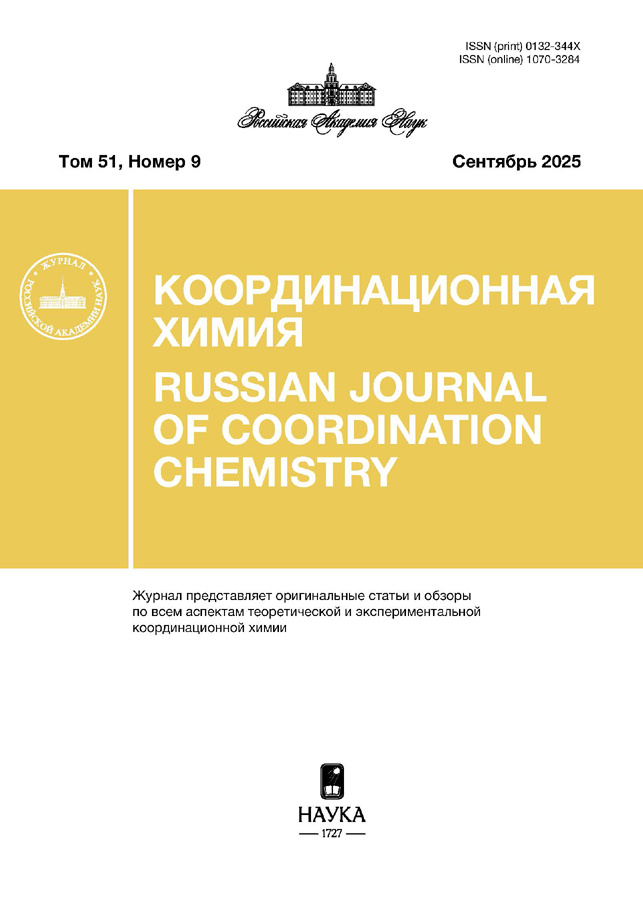Синтез и строение смешаннолигандных комплексных соединений свинца(II) с декагидро-клозо-декаборатным анионом и азагетероциклическими лигандами
- Авторы: Авдеева В.В.1, Кубасов А.С.1, Козерожец И.В.1, Никифорова С.Е.1, Малинина Е.А.1, Кузнецов Н.Т.1
-
Учреждения:
- Институт общей и неорганической химии им. Н. С. Курнакова
- Выпуск: Том 50, № 12 (2024)
- Страницы: 853–859
- Раздел: Статьи
- URL: https://cardiosomatics.ru/0132-344X/article/view/676749
- DOI: https://doi.org/10.31857/S0132344X24120052
- EDN: https://elibrary.ru/LMDMIW
- ID: 676749
Цитировать
Полный текст
Аннотация
Изучены реакции комплексообразования свинца(II) в присутствии солей клозо-декаборатного аниона [B10H10]2– и азагетероциклических лигандов 2,2΄-бипиридила (Bipy) и 1,10-фенантролина (Phen) в воде и органических растворителях (ацетонитрил, ДМФА). Выделен биядерный комплекс [Pb(Bipy)2[B10H10]] и полимерный комплекс [Pb(Phen)[B10H10]]. Изучено влияние растворителей и соотношения реагентов на состав и строение конечных комплексных соединений. Идентификация комплексных соединений проведена по данным элементного анализа, ИК-спектроскопии и РФА. Методом РСА установлено строение комплекса [Pb(Bipy)2[B10H10]]2 ⋅ 2CH3CN (CCDС № 2325841).
Ключевые слова
Полный текст
Об авторах
В. В. Авдеева
Институт общей и неорганической химии им. Н. С. Курнакова
Автор, ответственный за переписку.
Email: avdeeva.varvara@mail.ru
Россия, Москва
А. С. Кубасов
Институт общей и неорганической химии им. Н. С. Курнакова
Email: avdeeva.varvara@mail.ru
Россия, Москва
И. В. Козерожец
Институт общей и неорганической химии им. Н. С. Курнакова
Email: avdeeva.varvara@mail.ru
Россия, Москва
С. Е. Никифорова
Институт общей и неорганической химии им. Н. С. Курнакова
Email: avdeeva.varvara@mail.ru
Россия, Москва
Е. А. Малинина
Институт общей и неорганической химии им. Н. С. Курнакова
Email: avdeeva.varvara@mail.ru
Россия, Москва
Н. Т. Кузнецов
Институт общей и неорганической химии им. Н. С. Курнакова
Email: avdeeva.varvara@mail.ru
Россия, Москва
Список литературы
- Greenwood N.N., Earnshaw A. Chemistry of the Elements. School of Chemistry, University of Leeds, U. K. Butterworth-Heinemann, 1997.
- Boron Science: New Technologies and Applications / Ed. Hosmane N. S. CRC Press, 2012.
- Boron-Based Compounds: Potential and Emerging Applications in Medicine / Eds. Hey-Hawkins E., Viñas Teixidor C. John Wiley & Sons Ltd., 2018. https://doi.org/10.1002/9781119275602
- King R.B. // Chem. Rev. 2001. V. 101. P. 1119. https://doi.org/10.1021/cr000442t
- Chen Z., King R.B. // Chem. Rev. 2005. V. 105. P. 3613. https://doi.org/10.1021/cr0300892
- Ren L., Han Y., Hou X., Wu J. // Chem. 2021. V. 7. P. 3442. https://doi.org/10.1016/j.chempr.2021.11.003
- Klyukin I.N., Vlasova Yu.S., Novikov A.S. et al. // Symmetry. 2021. V. 13. P. 464. https://doi.org/10.3390/sym13030464
- Kal’tenberg A.A., Bashilova A.D., Somov N.V. et al. // Russ. J. Inorg. Chem. 2023. V. 68. P. 1247. https://doi.org/10.1134/S0036023623700286
- Stogniy M.Y., Bogdanova E.V., Anufriev S.A. et al. // Russ. J. Inorg. Chem. 2022. V. 67. P. 1537. https://doi.org/10.1134/S0036023622600848
- Núñez R., Romero I., Teixidor F., Viñas C. // Chem. Soc. Rev. 2016. V. 45. P. 5147. https://doi.org/10.1039/C6CS00159A
- Las’kova Y.N., Serdyukov A.A., Sivaev I.B. // Russ. J. Inorg. Chem. 2023. V. 68. P. 621. https://doi.org/10.1134/S0036023623600612
- Malinina E.A., Kubasov A.S., Nikiforova S.E. et al. // Polyhedron. 2024. V. 247. P. 116710. https://doi.org/10.1016/j.poly.2023.116710
- Exner R.M., Jenne C., Wegener B. // Z. Anorg. Allg. Chem. 2021. V. 647. P. 500. https://doi.org/10.1002/zaac.202000479
- Avdeeva V.V., Buzanov G.A., Malinina E.A. et al. // Crystals. 2020. V. 10. P. 389. https://doi.org/10.3390/cryst10050389
- Avdeeva V.V., Kubasov A.S., Golubev A.V. et al. // Inorg. Chim. Acta. 2023. V. 556. P. 121675. https://doi.org/10.1016/j.ica.2023.121675
- Zhdanov A.P., Voinova V.V., Klyukin I.N. et al. // Russ. J. Coord. Chem. 2019. V. 45. P. 563. https://doi.org/10.1134/S1070328419080098
- Malischewski M., Peryshkov D.V., Bukovsky E.V. et al. // Inorg. Chem. 2016. V. 55. P. 12254. https://doi.org/10.1021/acs.inorgchem.6b01980
- Volkov O., Hu C., Paetzold P. // Z. Anorg. Allg. Chem. 2005. V. 631. P. 1107. https://doi.org/10.1002/zaac.200400518
- Avdeeva V.V., Vologzhanina A.V., Korolenko S.E. et al. // Polyhedron. 2022. V. 223. P. 115932. https://doi.org/10.1016/j.poly.2022.115932
- Tiritiris I., Schleid T. // Z. Anorg. Allg. Chem. 2004. V. 630. P. 1555. https://doi.org/10.1002/zaac.200400167
- Tiritiris I., Schleid, T. // Z. Anorg. Allg. Chem. 2003. V. 629. P. 581. https://doi.org/10.1002/ZAAC.200390095
- Avdeeva V.V., Malinina E.A., Zhizhin K.Yu., Kuznetsov N.T. // Russ. J. Coord. Chem. 2021. V. 47. P. 519. https://doi.org/10.1134/S1070328421080017
- Malinina E.A., Kubasov A.S., Matveev E.Y. et al. // Polyhedron. 2023. V. 242. P. 116516. doi: 10.1016/j.poly.2023.116516
- Matveev E.Y., Avdeeva V.V., Kubasov A.S. et al. // Inorganics. 2023. V. 11. P. 144. https://doi.org/10.3390/inorganics11040144
- Lagun V.L., Katser S.B., Orlova A.M. et al. // Russ. J. Coord. Chem. 1992. V. 84. P. 365.
- Malinina E.A., Solntsev K.A., Butman L.A., Kuznetsov N.T. // Russ. J. Coord. Chim. 1989. V. 15. P. 1039.
- Lagun V.L., Orlova A.M., Katser S.V., et al. // Russ. J. Coord. Chem. 1994. V. 20. P. 431.
- Lagun V.L., Solntsev K.A., Katser S.V. et al. // Russ. J. Coord. Chem. 1994. V. 20. P. 504.
- Tiritiris I., Van N.-D., Schleid T. // Z. Anorg. Allg. Chem. 2011. V. 637. P. 682. https://doi.org/10.1002/zaac.201000457
- Avdeeva V.V., Vologzhanina A.V., Buzin M.I. et al. // Chem. Eur. J. 2017. V. 23. P. 16819. https://doi.org/10.1002/chem.201703285
- Avdeeva V.V., Polyakova I.N., Goeva L.V. et al. // Russ. J. Inorg. Chem. 2014. V. 59. P. 1247. https://doi.org/10.1134/S0036023614110047
- Malinina E.A., Goeva L.V., Kuznetsov N.T. // Russ. J. Inorg. Chem. 2009. V. 54. P. 417. https://doi.org/10.1134/S0036023609030152
- Matveev E.Y., Avdeeva V.V., Kubasov A.S. et al. // Inorganics. 2023. V. 11. P. 144. https://doi.org/10.3390/inorganics11040144
- Matveev E.Y., Dontsova O.S., Avdeeva V.V. et al. // Molecules. 2023. V. 28. P. 8073. https://doi.org/10.3390/molecules28248073
- Miller H.C., Miller N.E., Muetterties E.L. // J. Am. Chem. Soc. 1963. V. 85. P. 3885. https://doi.org/10.1021/ja00906a033
- Bruker, SAINT, Bruker AXS Inc., Madison, WI, 2018.
- Krause L., Herbst-Irmer R., Sheldrick G.M., Stalke D., J. Appl. Crystallogr. 2015. V. 48. P. 3. https://doi.org/10.1107/S1600576714022985
- Sheldrick G.M. // Acta Crystallogr. C. 2015. V. 71. P. 3.
- Dolomanov O.V., Bourhis L.J., Gildea R.J. et al. // J. Appl. Cryst. 2009. V. 42. P. 339.
- Turner M.J., McKinnon J.J., Wolff S.K. et al. // CrystalExplorer17.5. Perth: University of Western Australia, 2017).
Дополнительные файлы















